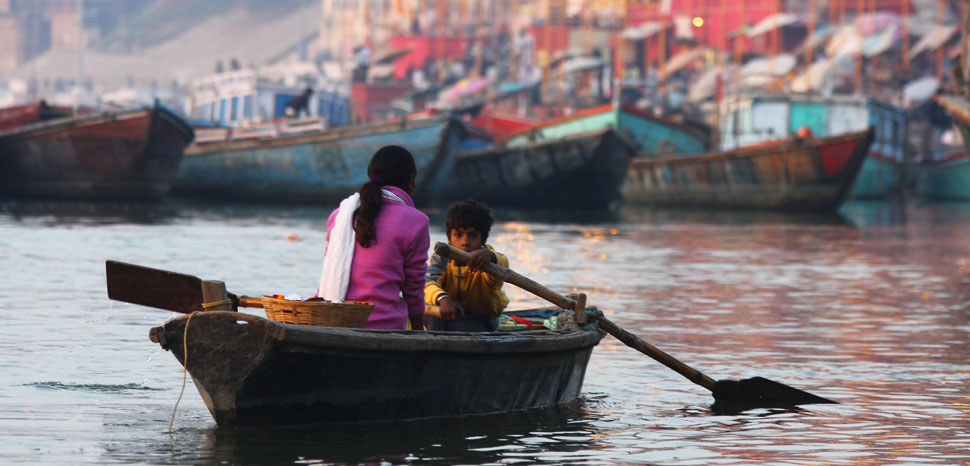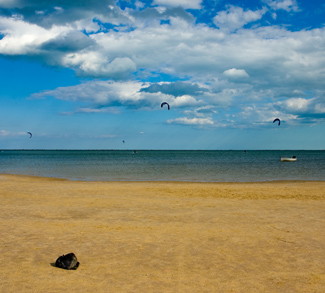In the name of globalization and development, humanity is fast destroying the very environment it inhabits. With uncontrolled emissions, melting glaciers, frequent floods and hurricanes, climate change and societal damage are a very real threat. And yet governments world over, despite signing landmark treaties, are either backtracking or approving catastrophic environmental clearances, such as Brazil allowing for mining in the world’s largest carbon sink of the Amazon basin, thereby stimulating irreversible damage to local culture and endangered species. The U.S. has more recently joined this league, and now our very own India as well.
India’s interlinking river (ILR) project is an ambitious government undertaking. It is uniquely remarkable given that it has the potential to enable greater equity in water distribution across the country, albeit with hidden costs – the big elephant in the room…
Nearly a century ago, archeologists discovered the remains of the Harappan civilization, which was established around 5,200 years ago. Prominent cities like Mohenjodaro were situated on the banks of Indus River and rain-fed Saraswati. However, around 1900 BC, the civilization began to decline, with the Indus River moving approximately 40 miles away from its main course, and the Saraswati progressively drying up. The monsoons, it seems, shifted eastwards with natural catastrophes becoming the norm of the day. The people were now forced to gradually migrate to the east, with a complete shift by 1600 BC.
If we compare India then and India now, there is not much difference, except for one fact – 1900 BC saw a natural decline, and 2100 AD will be anthropogenic…
Understandably, water management, which the ILR aims to achieve, is the need of the hour. Given that its scarcity has inadvertently caused farmers distress, with some resorting to suicide, while for others lack of fresh clean water means a plethora of, sometimes incurable, deadly diseases multiplied by their inability to get world-class health treatments. Adding to this are the erratic monsoons; while deadly floods have cost the country in its human resources. Indeed, the scheme, first envisioned during colonial India in 1858 and since then mooted several times, in the larger scheme of things is attractive. And yet the picture is not as rosy as it seems, with hazardous environmental and social consequences lurking in the shadows, consequences that cannot be overlooked.
India has enlisted foreign help in the sector, the most recent being the MoU signed between the Ministry of Water Resources, River Development and Ganga Rejuvenation, and the Ministry of Infrastructure and the Environment of the Kingdom of the Netherlands for bilateral cooperation in the field of water resources management. The agreement entails the enhancement of institutional and technical capacity of federal and state government agencies dealing with water resources, especially in the field of river basin management, and it has also registered pollution abatement in rivers, including Ganga, flood management, water quality, and the efficient use of water among its other aims.
Anthropogenic interference in the form of engineering new channels and routes for the rivers portends enormous ecological, human, and overall environmental damage in waiting.
Not very long ago in 2013, India was shaken by the Himalayan Tsunami. A multi-day cloudburst in the Indian state of Uttarakhand nestled in the lower Himalayas resulted in devastating floods, landslides, and massive human loss, becoming one of the worst natural disasters in recent history. Large amounts of unprecedented rainfall and debris chocking up rivers are considered to have caused the major overflows. Back then, a study by Utah State University concluded that the natural disaster was indeed man-made. Since the 1980s, the region had been experiencing heavy rainfall, which is often “associated with a tendency in the upper troposphere towards amplified short waves, and the phasing of such amplified short waves is tied to increased loading of greenhouse gases and aerosols.” Given that the region saw unscientific and poorly planned developments of roads, hotel-resorts, and most importantly more than 70 hydroelectric projects, the blueprint of the disaster was already drafted. Environmental experts stated that any activity undertaken towards building these 70 projects, such as tunneling and blasts underwrote the ecological imbalance in the state. Furthermore, with other streamside developments and river flow being restricted, landslides and excessive flooding was in the making. A misnomer of sorts for the other Himalayan states, these flash floods were a natural tragedy compounded by anthropogenic activities.
Four years later, the government plans to start an $87 billion scheme to connect nearly 60 rivers in the country in a gamble to end the wave of deadly droughts and floods… But a major question arises: Doesn’t linking rivers and changing their natural course invite yet another disaster?
Designed to be the world’s largest irrigation infrastructure project, the ILR program envisions building close to 15,000 km of new canals and 3,000 big and small dams and storage arrangements.
Broadly speaking, the scheme has two parts: The Himalayan rivers section which has 14 links, expected to transport 33 trillion liters of water per year, and the peninsular component which has 16 links, inclusive of the Godavari-Krishna link, which will transport 141 trillion liters per year. (It should be noted that most of the peninsular rivers are rain-fed while the Himalayan rivers originate from glaciers. Both are subject to climate change in their own ways.)
A suave engineering product, wherein the water from “surplus” river basins shall be transferred to “deficit” ones, ILR is not simply about diverting rivers. Given the multitude of the geographical terrain and topography the country is blessed with, complex engineering, decades of hard work – and of cost overruns – are only to be expected.
Anthropogenic interference in the form of engineering new channels and routes for the rivers, however, also portends enormous ecological, human, and overall environmental damage in waiting. Just like the 70+ hydro projects inadvertently became the cause of 2013 floods, will ILR with its proposed 30 canals and 3,000 dams have a similar fate?
With respect to Ken-Betwa project as the first leg of the ILR, Dr. Sudha Ramacharan writes on “the irreversible damage that reduced downstream flows would have on a river’s ecology and biodiversity. A change in the ecology of the River Ken on account of the Ken-Betwa link project in central India is expected to doom the already critically endangered gharial. Also, this project would submerge around 10 percent of the Panna Tiger reserve, reversing the huge gains of India’s tiger conservation project.”
For the uninitiated, the Ken- Betwa river link entails a 231-kilometre (144 mile) canal between the two rivers in the states of Madhya Pradesh and Uttar Pradesh, along with two dams and reservoirs; the felling of more than 1.8 million trees; and the usage of 6,017 hectares (23 sq miles) of forest land, including the Panna Tiger Reserve, with special mention of endangered wildlife species that will be impacted. The project is also expected to consume nearly 6,000 hectares of non-forest land, with approximately 5,000 homes being submerged as per the National Water Development Authority feasibility report.
This will conversely also have direct implications on climate change and India’s COP21 commitment.
One can expect large-scale deforestation to make way for dams and canals, thereby robbing us of the carbon sinks present in the country. This can result in increased greenhouse gases ratio in the atmosphere, leading to increases in temperature. Notably, India is a signatory to the Paris Treaty, having pledged to contribute toward maintaining a global temperature rise of under two degrees. However, the policymaking community seems to forget that forests are sacrosanct to balance out GHG emissions.
Next, the idea behind the project is to transfer surplus water from the donor basin, read the Ganga, to storage basins of Krishna & Godavari for instance. But what if the monsoon fails or, due to climate change, there is a change in the perennial system? Automatically, the entire project will be rendered a failure.
Additionally, shifting a river course will induce changes in the topography and vegetation, catalyzing the process of climate change. Thus, one should not rule out the possibility of a complete dry spell when changing the river course, as has happened in past across the world resulting in the end of great civilizations.
What does it mean to change a river course?
Naturally, the rivers meander owing to low gradient and water discharge. On plains, the rivers tend to take the easiest route which offers least resistance. However, depending upon the terrain, the river speed differs on different banks. Hereafter, the meandering process starts where there is a faster side of the river and less sediment deposits. This allows for further erosion and hence the formation of small curves. At the slower side of the river, more sediment from erosion of the outer curve is deposited. Over a period of time this meander gets more and more pronounced, while the slower side of the river further lags behind. Once the curves have sharpened, the river eventually re-establishes its path, thereby changing its course.
However, the river changing course has consequences such as:
The disappearance of villages and indigenous cultures, as has happened in the northeastern state of Arunanchal Pradesh, where the change in river course is due to climate change. Geologist Patnaik who is studying the impact of climate change in the state has categorically stated that: “under normal climatic conditions, rainfall would have been well-distributed throughout the year. Now, due to climate change, the pattern has changed. It has become erratic.”
On the flip side however, shifts of the Indus River and the subsequent disappearance of Saraswati, as often argued by archeologists, led to complete decline of the Indus-Saraswati Civilization. “The end was partly caused by changing river patterns. These changes included the drying up of the Hakra River and changes in the course of the Indus River. The river changes disrupted agricultural and economic systems, and many people left the cities of the Indus Valley region.”
“Evidence from many sources, including that of archaeological remains associated with old river courses, indicate that a major river, stemming mainly from the same sources as the present Sutlej, flowed through Northern Rajasthan, Bahawalpur and Sind – to the southeast of the present course of the Sutlej and the Indus – in the third to second millennium BC. This river, known as the Sarasvati in its upper course, at different times either joined the lower course of the Indus in Sind, or found its way independently into the Arabian Sea via Rann of Kutch.”
Another very eye-catching example is of the changing course of the river Semliki, marking the natural border between Uganda and the Democratic Republic of Congo, thereby leading to confusion in an oil-rich area. The boundary dispute between the two nations is an altogether different debate, but nonetheless the changing course of a river is instrumental yet again – this time as a national border.
There’s also a loss of biodiversity. Building dams and canals sometimes disconnect one area from another, thereby not allowing for the natural migration of certain species such as eels.
Thus, the ILR, which plans to connect rivers by carving new paths via means of thousands of canals and dams, is indeed a risky project. It entails within it the social, economic, and environmental costs which the country may or may not be able to pocket given the vulnerable ecosystems, diplomatic international commitments, sensitive societies, cultural xenophobia, and delicate economies in the wake of demonetization and a new tax structure.
India is now marching forward on its road to development, and though the Inter-Linking of Rivers Program does fit into the larger picture of a Developed India, one cannot ignore the hidden costs. In the other words, as Margaret Atwood writes in her 1971 classic Power Politics:
You fit into me
like a hook into an eye
a fish hook
an open eye.
The opinions, beliefs, and viewpoints expressed by the authors are theirs alone and don’t reflect any official position of Geopoliticalmonitor.com.




